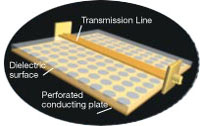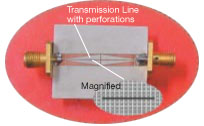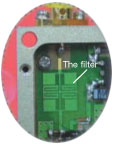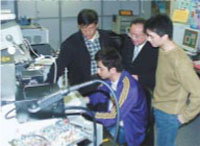|
|
.gif)
China’s successful global positioning system
(GPS) carries a vital filter produced from research at City University
of Hong Kong.
 Unlike
its American rival GPS which merely tells users their location,
China’s system is bi-directional which means it also reports
the user’s location to the operator. Unlike
its American rival GPS which merely tells users their location,
China’s system is bi-directional which means it also reports
the user’s location to the operator.
 |
 |
 |
 |
 |
| From top: The
filter device design that Prof Chan based his work on; how the
filter design was transformed and simplified; the filter as
a component in a GPS terminal; mesh filter screen of a microwave
oven; Prof Chan (centre) and some of his research team |
 Senior
scientific officer at CityU, Dr Xue Quan, said: “The Chinese
system is like a mobile phone rather than a pager.” The CityU
filter used in the Chinese system isolates microwave signals, so that
outward signals from the base station do not interfere with incoming
signals from the satellite at a different frequency. Without the filter,
the two signals may interfere with each other. Senior
scientific officer at CityU, Dr Xue Quan, said: “The Chinese
system is like a mobile phone rather than a pager.” The CityU
filter used in the Chinese system isolates microwave signals, so that
outward signals from the base station do not interfere with incoming
signals from the satellite at a different frequency. Without the filter,
the two signals may interfere with each other.
 The filter
was invented from research left on the shelf at University of California
(UCLA), said Principal Investigator Prof Chi-hou Chan The filter
was invented from research left on the shelf at University of California
(UCLA), said Principal Investigator Prof Chi-hou Chan
 Prof Chan’s
starting point was the UCLA filter concept based on a transmission
line over a flat plane consisting of a dielectric or insulating surface,
such as plastic or ceramics, on a perforated conductor plate (see
graphic). Prof Chan’s
starting point was the UCLA filter concept based on a transmission
line over a flat plane consisting of a dielectric or insulating surface,
such as plastic or ceramics, on a perforated conductor plate (see
graphic).
 It was
found that the electrical performance in the transmission line depended
on the perforated structure in the conductor plate. It also depended
on the angle of the transmission line going over the perforations. It was
found that the electrical performance in the transmission line depended
on the perforated structure in the conductor plate. It also depended
on the angle of the transmission line going over the perforations.
 “In
simple terms,” said Prof Chan, “depending on the perforation
pattern, the signal in the transmission line will travel at different
speeds.” “In
simple terms,” said Prof Chan, “depending on the perforation
pattern, the signal in the transmission line will travel at different
speeds.”
 As a next
step, Prof Chan and his researchers discovered that the same result
could be obtained by perforating the transmission line. This meant
perforations on the baseboard were unnecessary and helped compact
and simplify the filter design. As a next
step, Prof Chan and his researchers discovered that the same result
could be obtained by perforating the transmission line. This meant
perforations on the baseboard were unnecessary and helped compact
and simplify the filter design.
 Another
step in the research was to miniaturise the entire filter so that
it could be incorporated in a printed circuit (see graphic). Another
step in the research was to miniaturise the entire filter so that
it could be incorporated in a printed circuit (see graphic).
 For applications
using a printed circuit, the filter could therefore be included at
virtually no extra cost. For applications
using a printed circuit, the filter could therefore be included at
virtually no extra cost.
 An additional
benefit of the CityU filter, termed a Compact Microstrip Resonant
Cell (CMRC), is that it eliminates a fault in the original design
where the perforations led to energy leakage at certain frequencies. An additional
benefit of the CityU filter, termed a Compact Microstrip Resonant
Cell (CMRC), is that it eliminates a fault in the original design
where the perforations led to energy leakage at certain frequencies.
 The filter
works like the perforated screen door on a microwave oven, explained
Prof Chan. “In the microwave oven, the perforated screen allows
light to go through the door but blocks the microwave frequency so
is called a high pass filter. The filter
works like the perforated screen door on a microwave oven, explained
Prof Chan. “In the microwave oven, the perforated screen allows
light to go through the door but blocks the microwave frequency so
is called a high pass filter.
 “Our
filter is slightly different as it blocks high frequencies but allows
low frequencies to pass, so is a low pass filter. The distance between
the perforations is critical.” A development of the filter the
researchers are working on will allow a band of frequencies to pass,
blocking frequencies both above and below the band. “Our
filter is slightly different as it blocks high frequencies but allows
low frequencies to pass, so is a low pass filter. The distance between
the perforations is critical.” A development of the filter the
researchers are working on will allow a band of frequencies to pass,
blocking frequencies both above and below the band.
 Prof Chan
sees huge potential for China’s global positioning system. “For
example, if all cargo containers are fitted with them, an operator
would know all their locations at any one time. The system could also
be fitted to tourist buses,” he said. “Ultimately, terminals
could be standard on most cars using China’s roads.” Prof Chan
sees huge potential for China’s global positioning system. “For
example, if all cargo containers are fitted with them, an operator
would know all their locations at any one time. The system could also
be fitted to tourist buses,” he said. “Ultimately, terminals
could be standard on most cars using China’s roads.”
Principal Investigator
Prof Chi-hou Chan : eechic@cityu.edu.hk

|

